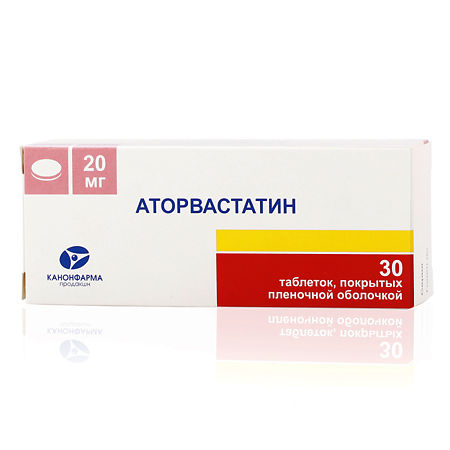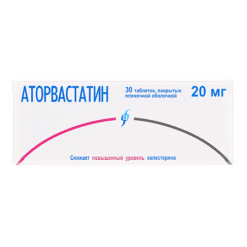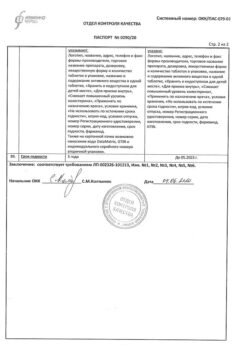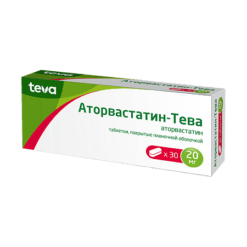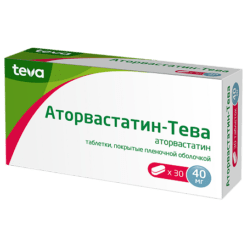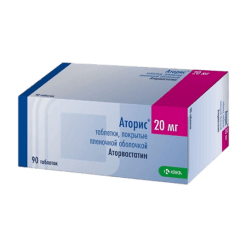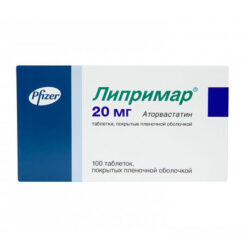No products in the cart.
Atorvastatin, 20 mg 30 pcs
€1.00
Out of stock
(E-mail when Stock is available)
Description
Pharmacodynamics
Atorvastatin is a hypolipidemic drug from the group of statins. Selective competitive inhibitor of HMG-CoA reductase – an enzyme that converts 3-hydroxy-3-methylglutaryl coenzyme A into mevalonic acid, which is a precursor of sterols, including cholesterol. Triglycerides (TG) and cholesterol in the liver are incorporated into very low-density lipoproteins (VLDL), entered into the blood plasma and transported to peripheral tissues. Low-density lipoproteins (LDL) are formed from VLDL during interaction with LDL receptors. Atorvastatin reduces plasma levels of cholesterol and lipoproteins by inhibiting HMG-CoA reductase, cholesterol synthesis in the liver and increasing the number of “hepatic” LDL receptors on cell surface that leads to increased capture and catabolism of LDL.
Decreases formation of LDL, causes a marked and persistent increase in LDL receptor activity. Reduces LDL levels in patients with homozygous familial hypercholesterolemia, which usually does not respond to therapy with hypolipidemic agents. Reduces total cholesterol by 30-46%, LDL by 41-61%, apolipoprotein B by 34-50% and TG by 14-33%; causes an increase in HDL (high-density lipoprotein) cholesterol and apolipoprotein A. Dose-dependently reduces LDL levels in patients with homozygous hereditary hypercholesterolemia resistant to therapy with other hypolipidemic agents.
Pharmacokinetics
Absorption is high. Maximal concentration (Cmax) in plasma is reached after 1-2 hours, Cmax in women is 20% higher, area under the curve/concentration, time (AUC) – 10% lower; Cmax in patients with alcoholic cirrhosis is 16 times higher than normal, AUC – 11 times higher.
Food slightly reduces speed and duration of drug absorption (by 25% and 9%, respectively), but decrease of LDL cholesterol is similar to that with Atorvastatin without food. Concentration of Atorvastatin when administered in the evening is lower than in the morning (approximately by 30%). A linear relationship between the degree of absorption and the drug dose has been found.
Bioavailability is 12%, systemic bioavailability of HMG-CoA reductase inhibitory activity is 30%. Low systemic bioavailability is due to presystemic metabolism in the gastrointestinal mucosa and during “first passage” through the liver.
The average volume of distribution is 381 liters, the binding to plasma proteins is 98%. It is metabolized mainly in liver under the action of CYP3A4, CYP3A5 and CYP3A7 cytochrome with formation of pharmacological active metabolites (ortho- and parahydroxylated derivatives, beta-oxidation products). In vitro, ortho- and parahydroxylated metabolites have an inhibitory effect on HMG-CoA reductase, comparable with that of Atorvastatin. The inhibitory effect of the drug against HMG-CoA reductase is approximately 70% determined by the activity of circulating metabolites.
Extracted with bile after hepatic and/or extrahepatic metabolism (not subjected to marked intestinal-hepatic recirculation).
The elimination half-life is 14 hours. Inhibitory activity against HMG-CoA reductase lasts about 20-30 hours due to the presence of active metabolites. Less than 2% of the oral dose is detected in the urine. It is not excreted during hemodialysis.
Indications
Indications
Active ingredient
Active ingredient
Composition
Composition
1 film-coated tablet contains:
The active ingredient:
Calcium atorvastatin (converted to atorvastatin) 20.72 mg (20 mg).
Auxiliary substances:
calcium hydrophosphate dihydrate,
sodium carboxymethyl starch,
Potato starch,
Magnesium stearate,
Microcrystalline cellulose,
Film coating:
Shell (finished Opadray white or finished Vivacoat mixture can be used), including: hypromellose (hydroxypropyl methylcellulose), hyprolose (hydroxypropyl cellulose), talc, titanium dioxide.
How to take, the dosage
How to take, the dosage
Ingestion.
Before prescribing Atorvastatin, a standard hypolipidemic diet should be recommended for the patient, which the patient should continue to follow during the entire period of therapy.
The initial dose is on average 10 mg/day. The dose varies from 10 to 80 mg/day.
The drug can be taken at any time of the day with food or regardless of the time of meals. The dose is adjusted with regard to baseline cholesterol/LDL levels, the goal of therapy, and individual effect. At the beginning of treatment and/or during dose increase of Atorvastatin it is necessary to monitor plasma lipid levels every 2-4 weeks and adjust the dose accordingly.
In order to ensure the following dosing regimen of the drug it is possible to use Atorvastatin in other dosage forms: film-coated tablets 10 mg and 20 mg. The maximum daily dose of the drug is 80 mg.
In concomitant use with cyclosporine, the daily dose of Atorvastatin should not exceed 10 mg.
Primary hypercholesterolemia and mixed hyperlipidemia. In most cases, it is sufficient to prescribe a dose of 10 mg of Atorvastatin once daily. Significant therapeutic effect is observed after 2 weeks, and the maximum therapeutic effect is usually observed after 4 weeks. With long-term treatment this effect is maintained.
Patient special groups
Kidney function disorders. Administration of the drug in patients with renal insufficiency and renal diseases does not influence on plasma levels of Atorvastatin or degree of cholesterol/LDL decrease with its use, therefore no change of drug dose is required.
Hepatic disorders. In case of hepatic insufficiency, the dose should be reduced.
Elderly patients. No differences in safety, efficacy or achievement of hypolipidemic therapy goals have been noted when using the drug in elderly patients compared to the general population.
Interaction
Interaction
The risk of myopathy during treatment with other drugs of this class is increased with concomitant use of cyclosporine, fibrates, erythromycin, azole antifungals and nicotinic acid.
Concomitant oral administration of Atorvastatin and suspension containing magnesium and aluminum hydroxide decreased plasma concentrations of Atorvastatin by approximately 35%, but the degree of decrease in cholesterol/LDL levels was not changed.
In concomitant use Atorvastatin does not affect pharmacokinetics of antipyrine (phenazone), therefore, interaction with other drugs metabolized by the same cytochrome isoenzymes is not expected.
Concomitant use of colestipol decreased plasma concentrations of Atorvastatin by approximately 25%. However, the hypolipidemic effect of combination of Atorvastatin and colestipol was superior to that of each drug separately.
The equilibrium plasma concentrations of digoxin and Atorvastatin at a dose of 10 mg did not change when digoxin and Atorvastatin were repeatedly administered. However, when using digoxin in combination with Atorvastatin at a dose of 80 mg/day, digoxin concentrations increased by approximately 20%. Patients receiving digoxin in combination with Atorvastatin should be monitored.
In concomitant use of Atorvastatin and erythromycin (500 mg 4 times/day) or clarithromycin (500 mg 2 times/day), which inhibit cytochrome Ð 450 3A4, an increase in plasma concentration of Atorvastatin was observed.
Concomitant administration of Atorvastatin (10 mg once daily) and azithromycin (500 mg once daily) did not change Atorvastatin plasma concentration.
Atorvastatin had no clinically significant effect on plasma concentrations of terfenadine, which is metabolized primarily by cytochrome Ð 450 3Ð4; in this regard, it seems unlikely that Atorvastatin can significantly affect pharmacokinetic parameters of other cytochrome Ð 450 3Ð4 substrates.
In concomitant use of Atorvastatin and oral contraceptives containing norethindrone and ethinylestradiol, a significant increase in AUC of norethindrone and ethinylestradiol of approximately 30% and 20% respectively was observed. This effect should be considered when choosing an oral contraceptive for a woman receiving Atorvastatin.
Concomitant use with drugs that reduce the concentration of endogenous steroid hormones (including cimetidine, ketoconazole, spironolactone) increases the risk of reduction of endogenous steroid hormones (caution should be exercised).
In studying the interaction of Atorvastatin with warfarin and cimetidine no signs of clinically significant interaction were found.
The pharmacokinetics of Atorvastatin 80 mg and amlodipine 10 mg in equilibrium have not changed.
There were no clinically significant adverse interactions between Atorvastatin and antihypertensive agents.
The concomitant use of Atorvastatin with protease inhibitors known as cytochrome P450 3A4 inhibitors was accompanied by an increase in plasma concentration of Atorvastatin.
Pharmaceutical incompatibility is not known.
Special Instructions
Special Instructions
Before starting therapy with Atorvastatin, the patient should be prescribed a standard hypocholesterolemic diet, which should be followed during the entire period of treatment.
The use of HMG-CoA reductase inhibitors to reduce blood lipid levels may lead to changes in biochemical parameters reflecting liver function. Liver function should be monitored before the start of therapy, at 6 weeks, 12 weeks after the start of Atorvastatin administration and after each dose increase as well as periodically, e.g., every 6 months. Elevation of serum hepatic enzymes activity may be observed during Atorvastatin therapy. Patients with increased enzyme levels should be monitored until enzyme levels return to normal. In case if values of alanine aminotransferase (ALT) or asparagine aminotransferase (AST) exceed more than 3 times the upper allowable limit, it is recommended to reduce Atorvastatin dose or discontinue treatment.
Atorvastatin should be used with caution in patients who abuse alcohol and/or have liver disease. Active liver disease or persistent increase in aminotransferase activity of unclear genesis are contraindications to Atorvastatin administration.
Treatment with Atorvastatin may cause myopathy. The diagnosis of myopathy (pain and weakness in muscles combined with an increase in creatine phosphokinase (CPK) activity more than 10 times the upper limit of normal) should be discussed in patients with widespread myalgia, muscle soreness or weakness and/or a marked increase in CPK activity. Patients should be warned to inform their physician immediately of unexplained muscle pain or weakness if accompanied by malaise or fever. Atorvastatin therapy should be discontinued in case of marked increase in CPK activity or in the presence of confirmed or suspected myopathy. Risk of myopathy during treatment with other drugs of this class was increased with concomitant use of cyclosporine, fibrates, erythromycin, nicotinic acid or azole antifungal agents. Many of these drugs inhibit cytochrome P450 3A4-mediated metabolism and/or drug transport. Atorvastatin is biotransformed by CYP 3A4. Prescribing Atorvastatin in combination with fibrates, erythromycin, immunosuppressive agents, azole antifungal agents or nicotinic acid in hypolipidemic doses, the expected benefits and risks of treatment should be carefully weighed and patients should be regularly observed to detect muscle pain or weakness, especially during the first months of treatment and during periods of increasing doses of any drug. In such situations, periodic determination of CPK activity may be recommended, although such monitoring does not prevent the development of severe myopathy.
In Atorvastatin, as well as other drugs of this class, there have been cases of rhabdomyolysis with acute renal failure due to myoglobinuria. Atorvastatin therapy should be temporarily discontinued or completely discontinued in case of signs of possible myopathy or in presence of risk factor of renal failure during rhabdomyolysis (for example, severe acute infection, arterial hypotension, serious surgery, trauma, severe metabolic, endocrine and electrolyte disorders and uncontrolled convulsions).
Before starting therapy with Atorvastatin, an attempt should be made to achieve control of hypercholesterolemia through adequate diet therapy, increasing physical activity, reducing body weight in obese patients and treating other conditions.
Patients should be warned to seek immediate medical attention if they experience unexplained muscle pain or weakness, especially if accompanied by malaise or fever.
Influence on driving and operating machinery
There have been no reports of adverse effects of Atorvastatin on driving and operating machinery.
Contraindications
Contraindications
The drug should be used with caution in patients with chronic alcoholism, history of liver disease, severe electrolyte balance disorders, endocrine and metabolic disorders, arterial hypotension, severe acute infections (sepsis), uncontrolled epilepsy, extensive surgical interventions, trauma, skeletal muscle diseases.
Side effects
Side effects
Nervous system disorders: insomnia, dizziness; headache, asthenia, malaise, somnolence, nightmares, paresthesias, peripheral neuropathy, amnesia, emotional lability, ataxia, facial nerve paralysis, hyperkinesias, migraine, depression, hypoesthesia, loss of consciousness.
Senses: amblyopia, tinnitus, dry conjunctiva, accommodation disorder, retinal hemorrhage, deafness, glaucoma, parosmia, loss of sense of taste, perversion of taste.
Cardiovascular system: chest pain; palpitations, symptoms of vasodilation, orthostatic hypotension, increased BP, phlebitis, arrhythmias, angina pectoris.
Hematopoietic system disorders: anemia, lymphoadenopathy, thrombocytopenia.
Respiratory system: bronchitis, rhinitis; pneumonia, dyspnea, exacerbation of bronchial asthma, nasal bleeding.
Digestive system disorders: nausea; heartburn, constipation or diarrhea, flatulence, gastralgia, abdominal pain, decreased or increased appetite, dry mouth, belching, dysphagia, vomiting, stomatitis, esophagitis, glossitis, erosive and ulcerative lesions of the oral mucosa, gastroenteritis, hepatitis, biliary colic, cheilitis, duodenal ulcer, pancreatitis, cholestatic jaundice, liver dysfunction, rectal bleeding, melena, bleeding gums, tenesmus.
Muscular system disorders: arthritis; leg muscle cramps, bursitis, tenosynovitis, myositis, myopathy, arthralgia, myalgia, rhabdomyolysis, torticollis, muscle hypertonicity, joint contractures, joint swelling, tendopathy (in some cases with tendon rupture).
Urogenital system: urogenital infections, peripheral edema; < 1% – dysuria (including Pollakiuria, nycturia, urinary incontinence or urinary retention, imperative urge to urinate), leukocyturia, nephritis, hematuria, vaginal bleeding, nephrourolithiasis, metrorrhagia, epididymitis, decreased libido, impotence, ejaculation disorders.
Dermatological reactions: alopecia, xeroderma, photosensitization, increased sweating, eczema, seborrhea, ecchymoses, petechiae.
Endocrine system disorders: gynecomastia, mastodynia.
Metabolism disorders: weight gain, aggravation of gout.
Allergic reactions: skin itching, skin rash, contact dermatitis, rarely – urticaria, angioedema, facial edema, anaphylaxis, erythema multiforme (including Stevens-Johnson syndrome), toxic epidermal necrolysis (Lyell’s syndrome).
Laboratory measures: hyperglycemia, hypoglycemia, increased serum CPK, albuminuria.
Overdose
Overdose
Treatment: there is no specific antidote, symptomatic therapy is carried out. Hemodialysis is ineffective.
Pregnancy use
Pregnancy use
Atorvastatin is contraindicated during pregnancy and lactation (breastfeeding).
It is unknown whether Atorvastatin is excreted with breast milk. Taking into account the possibility of adverse events in breastfed children, if it is necessary to use the drug during lactation, the question of stopping breastfeeding should be considered.
Women of reproductive age should use adequate contraceptive methods during treatment. Atorvastatin can be administered to women of reproductive age only if they are very unlikely to become pregnant and the patient is informed about the possible risk of treatment to the fetus.
Similarities
Similarities
Additional information
| Shelf life | 2 years |
|---|---|
| Conditions of storage | In a dry, light-protected place at a temperature not exceeding 25 °C |
| Manufacturer | Kanonfarma Production ZAO, Russia |
| Medication form | pills |
| Brand | Kanonfarma Production ZAO |
Other forms…
Related products
Buy Atorvastatin, 20 mg 30 pcs with delivery to USA, UK, Europe and over 120 other countries.

